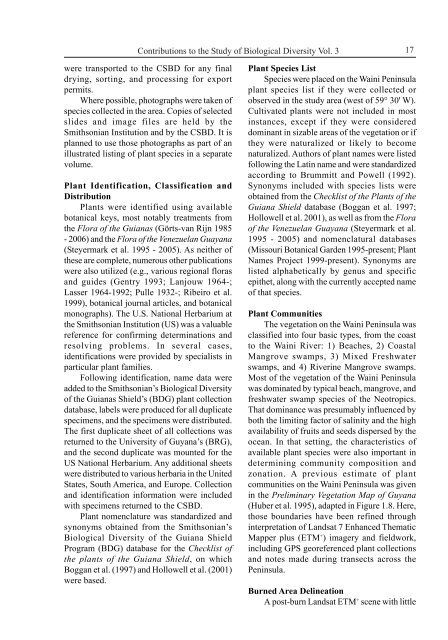Plant Community Structure, Fire Disturbance, and Recovery in ...
Plant Community Structure, Fire Disturbance, and Recovery in ...
Plant Community Structure, Fire Disturbance, and Recovery in ...
Create successful ePaper yourself
Turn your PDF publications into a flip-book with our unique Google optimized e-Paper software.
Contributions to the Study of Biological Diversity Vol. 3<br />
were transported to the CSBD for any f<strong>in</strong>al<br />
dry<strong>in</strong>g, sort<strong>in</strong>g, <strong>and</strong> process<strong>in</strong>g for export<br />
permits.<br />
Where possible, photographs were taken of<br />
species collected <strong>in</strong> the area. Copies of selected<br />
slides <strong>and</strong> image files are held by the<br />
Smithsonian Institution <strong>and</strong> by the CSBD. It is<br />
planned to use those photographs as part of an<br />
illustrated list<strong>in</strong>g of plant species <strong>in</strong> a separate<br />
volume.<br />
<strong>Plant</strong> Identification, Classification <strong>and</strong><br />
Distribution<br />
<strong>Plant</strong>s were identified us<strong>in</strong>g available<br />
botanical keys, most notably treatments from<br />
the Flora of the Guianas (Görts-van Rijn 1985<br />
- 2006) <strong>and</strong> the Flora of the Venezuelan Guayana<br />
(Steyermark et al. 1995 - 2005). As neither of<br />
these are complete, numerous other publications<br />
were also utilized (e.g., various regional floras<br />
<strong>and</strong> guides (Gentry 1993; Lanjouw 1964-;<br />
Lasser 1964-1992; Pulle 1932-; Ribeiro et al.<br />
1999), botanical journal articles, <strong>and</strong> botanical<br />
monographs). The U.S. National Herbarium at<br />
the Smithsonian Institution (US) was a valuable<br />
reference for confirm<strong>in</strong>g determ<strong>in</strong>ations <strong>and</strong><br />
resolv<strong>in</strong>g problems. In several cases,<br />
identifications were provided by specialists <strong>in</strong><br />
particular plant families.<br />
Follow<strong>in</strong>g identification, name data were<br />
added to the Smithsonian’s Biological Diversity<br />
of the Guianas Shield’s (BDG) plant collection<br />
database, labels were produced for all duplicate<br />
specimens, <strong>and</strong> the specimens were distributed.<br />
The first duplicate sheet of all collections was<br />
returned to the University of Guyana’s (BRG),<br />
<strong>and</strong> the second duplicate was mounted for the<br />
US National Herbarium. Any additional sheets<br />
were distributed to various herbaria <strong>in</strong> the United<br />
States, South America, <strong>and</strong> Europe. Collection<br />
<strong>and</strong> identification <strong>in</strong>formation were <strong>in</strong>cluded<br />
with specimens returned to the CSBD.<br />
<strong>Plant</strong> nomenclature was st<strong>and</strong>ardized <strong>and</strong><br />
synonyms obta<strong>in</strong>ed from the Smithsonian’s<br />
Biological Diversity of the Guiana Shield<br />
Program (BDG) database for the Checklist of<br />
the plants of the Guiana Shield, on which<br />
Boggan et al. (1997) <strong>and</strong> Hollowell et al. (2001)<br />
were based.<br />
17<br />
<strong>Plant</strong> Species List<br />
Species were placed on the Wa<strong>in</strong>i Pen<strong>in</strong>sula<br />
plant species list if they were collected or<br />
observed <strong>in</strong> the study area (west of 59° 30' W).<br />
Cultivated plants were not <strong>in</strong>cluded <strong>in</strong> most<br />
<strong>in</strong>stances, except if they were considered<br />
dom<strong>in</strong>ant <strong>in</strong> sizable areas of the vegetation or if<br />
they were naturalized or likely to become<br />
naturalized. Authors of plant names were listed<br />
follow<strong>in</strong>g the Lat<strong>in</strong> name <strong>and</strong> were st<strong>and</strong>ardized<br />
accord<strong>in</strong>g to Brummitt <strong>and</strong> Powell (1992).<br />
Synonyms <strong>in</strong>cluded with species lists were<br />
obta<strong>in</strong>ed from the Checklist of the <strong>Plant</strong>s of the<br />
Guiana Shield database (Boggan et al. 1997;<br />
Hollowell et al. 2001), as well as from the Flora<br />
of the Venezuelan Guayana (Steyermark et al.<br />
1995 - 2005) <strong>and</strong> nomenclatural databases<br />
(Missouri Botanical Garden 1995-present; <strong>Plant</strong><br />
Names Project 1999-present). Synonyms are<br />
listed alphabetically by genus <strong>and</strong> specific<br />
epithet, along with the currently accepted name<br />
of that species.<br />
<strong>Plant</strong> Communities<br />
The vegetation on the Wa<strong>in</strong>i Pen<strong>in</strong>sula was<br />
classified <strong>in</strong>to four basic types, from the coast<br />
to the Wa<strong>in</strong>i River: 1) Beaches, 2) Coastal<br />
Mangrove swamps, 3) Mixed Freshwater<br />
swamps, <strong>and</strong> 4) River<strong>in</strong>e Mangrove swamps.<br />
Most of the vegetation of the Wa<strong>in</strong>i Pen<strong>in</strong>sula<br />
was dom<strong>in</strong>ated by typical beach, mangrove, <strong>and</strong><br />
freshwater swamp species of the Neotropics.<br />
That dom<strong>in</strong>ance was presumably <strong>in</strong>fluenced by<br />
both the limit<strong>in</strong>g factor of sal<strong>in</strong>ity <strong>and</strong> the high<br />
availability of fruits <strong>and</strong> seeds dispersed by the<br />
ocean. In that sett<strong>in</strong>g, the characteristics of<br />
available plant species were also important <strong>in</strong><br />
determ<strong>in</strong><strong>in</strong>g community composition <strong>and</strong><br />
zonation. A previous estimate of plant<br />
communities on the Wa<strong>in</strong>i Pen<strong>in</strong>sula was given<br />
<strong>in</strong> the Prelim<strong>in</strong>ary Vegetation Map of Guyana<br />
(Huber et al. 1995), adapted <strong>in</strong> Figure 1.8. Here,<br />
those boundaries have been ref<strong>in</strong>ed through<br />
<strong>in</strong>terpretation of L<strong>and</strong>sat 7 Enhanced Thematic<br />
Mapper plus (ETM + ) imagery <strong>and</strong> fieldwork,<br />
<strong>in</strong>clud<strong>in</strong>g GPS georeferenced plant collections<br />
<strong>and</strong> notes made dur<strong>in</strong>g transects across the<br />
Pen<strong>in</strong>sula.<br />
Burned Area Del<strong>in</strong>eation<br />
A post-burn L<strong>and</strong>sat ETM + scene with little
















